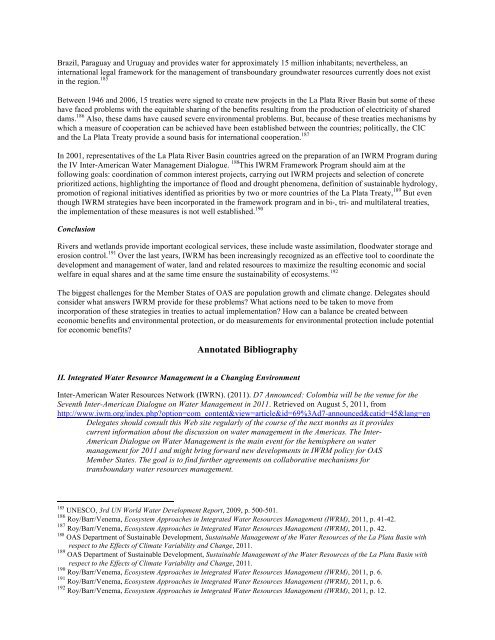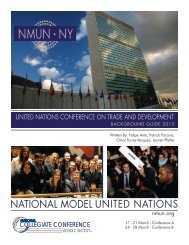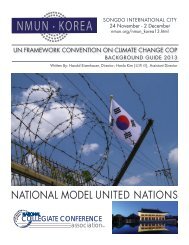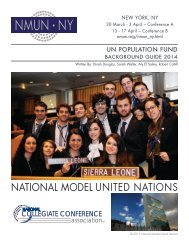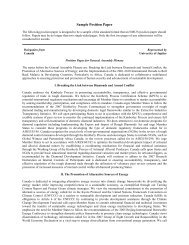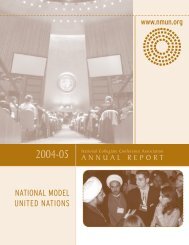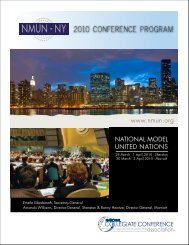Organization of American States - National Model United Nations
Organization of American States - National Model United Nations
Organization of American States - National Model United Nations
You also want an ePaper? Increase the reach of your titles
YUMPU automatically turns print PDFs into web optimized ePapers that Google loves.
Brazil, Paraguay and Uruguay and provides water for approximately 15 million inhabitants; nevertheless, an<br />
international legal framework for the management <strong>of</strong> transboundary groundwater resources currently does not exist<br />
in the region. 185<br />
Between 1946 and 2006, 15 treaties were signed to create new projects in the La Plata River Basin but some <strong>of</strong> these<br />
have faced problems with the equitable sharing <strong>of</strong> the benefits resulting from the production <strong>of</strong> electricity <strong>of</strong> shared<br />
dams. 186 Also, these dams have caused severe environmental problems. But, because <strong>of</strong> these treaties mechanisms by<br />
which a measure <strong>of</strong> cooperation can be achieved have been established between the countries; politically, the CIC<br />
and the La Plata Treaty provide a sound basis for international cooperation. 187<br />
In 2001, representatives <strong>of</strong> the La Plata River Basin countries agreed on the preparation <strong>of</strong> an IWRM Program during<br />
the IV Inter-<strong>American</strong> Water Management Dialogue. 188 This IWRM Framework Program should aim at the<br />
following goals: coordination <strong>of</strong> common interest projects, carrying out IWRM projects and selection <strong>of</strong> concrete<br />
prioritized actions, highlighting the importance <strong>of</strong> flood and drought phenomena, definition <strong>of</strong> sustainable hydrology,<br />
promotion <strong>of</strong> regional initiatives identified as priorities by two or more countries <strong>of</strong> the La Plata Treaty, 189 But even<br />
though IWRM strategies have been incorporated in the framework program and in bi-, tri- and multilateral treaties,<br />
the implementation <strong>of</strong> these measures is not well established. 190<br />
Conclusion<br />
Rivers and wetlands provide important ecological services, these include waste assimilation, floodwater storage and<br />
erosion control. 191 Over the last years, IWRM has been increasingly recognized as an effective tool to coordinate the<br />
development and management <strong>of</strong> water, land and related resources to maximize the resulting economic and social<br />
welfare in equal shares and at the same time ensure the sustainability <strong>of</strong> ecosystems. 192<br />
The biggest challenges for the Member <strong>States</strong> <strong>of</strong> OAS are population growth and climate change. Delegates should<br />
consider what answers IWRM provide for these problems? What actions need to be taken to move from<br />
incorporation <strong>of</strong> these strategies in treaties to actual implementation? How can a balance be created between<br />
economic benefits and environmental protection, or do measurements for environmental protection include potential<br />
for economic benefits?<br />
Annotated Bibliography<br />
II. Integrated Water Resource Management in a Changing Environment<br />
Inter-<strong>American</strong> Water Resources Network (IWRN). (2011). D7 Announced: Colombia will be the venue for the<br />
Seventh Inter-<strong>American</strong> Dialogue on Water Management in 2011. Retrieved on August 5, 2011, from<br />
http://www.iwrn.org/index.php?option=com_content&view=article&id=69%3Ad7-announced&catid=45&lang=en<br />
Delegates should consult this Web site regularly <strong>of</strong> the course <strong>of</strong> the next months as it provides<br />
current information about the discussion on water management in the Americas. The Inter-<br />
<strong>American</strong> Dialogue on Water Management is the main event for the hemisphere on water<br />
management for 2011 and might bring forward new developments in IWRM policy for OAS<br />
Member <strong>States</strong>. The goal is to find further agreements on collaborative mechanisms for<br />
transboundary water resources management.<br />
185<br />
UNESCO, 3rd UN World Water Development Report, 2009, p. 500-501.<br />
186<br />
Roy/Barr/Venema, Ecosystem Approaches in Integrated Water Resources Management (IWRM), 2011, p. 41-42.<br />
187<br />
Roy/Barr/Venema, Ecosystem Approaches in Integrated Water Resources Management (IWRM), 2011, p. 42.<br />
188<br />
OAS Department <strong>of</strong> Sustainable Development, Sustainable Management <strong>of</strong> the Water Resources <strong>of</strong> the La Plata Basin with<br />
respect to the Effects <strong>of</strong> Climate Variability and Change, 2011.<br />
189<br />
OAS Department <strong>of</strong> Sustainable Development, Sustainable Management <strong>of</strong> the Water Resources <strong>of</strong> the La Plata Basin with<br />
respect to the Effects <strong>of</strong> Climate Variability and Change, 2011.<br />
190<br />
Roy/Barr/Venema, Ecosystem Approaches in Integrated Water Resources Management (IWRM), 2011, p. 6.<br />
191<br />
Roy/Barr/Venema, Ecosystem Approaches in Integrated Water Resources Management (IWRM), 2011, p. 6.<br />
192<br />
Roy/Barr/Venema, Ecosystem Approaches in Integrated Water Resources Management (IWRM), 2011, p. 12.


